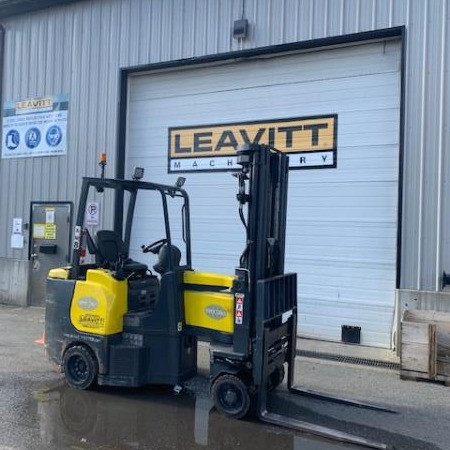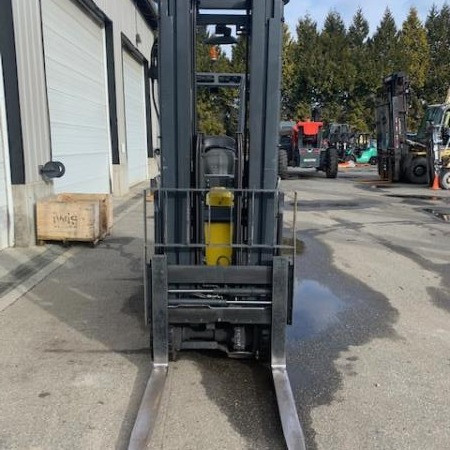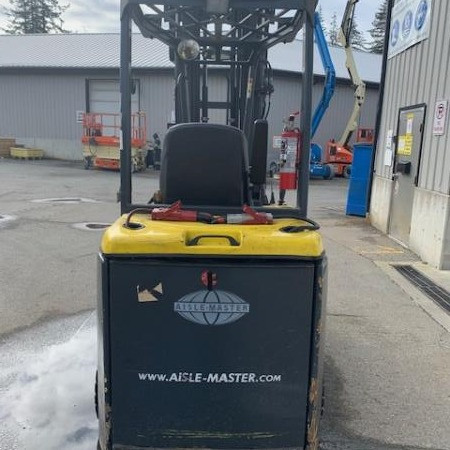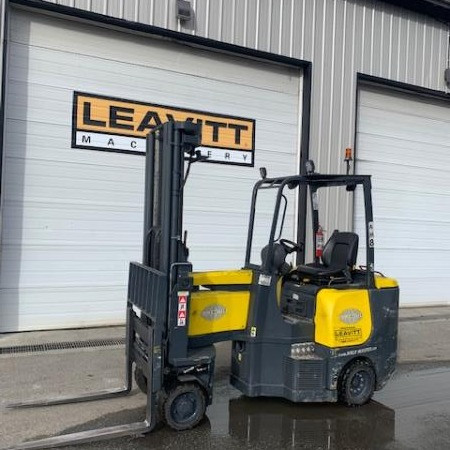Very Narrow Aisle Forklift Illinois
Used Very Narrow Aisle Forklift Illinois - Warehousing needs greatly focus on space-saving techniques and layout to maximize expensive square footage and decrease travel time needed to get goods from the loading docks and from point A to point B. Extremely narrow aisles offer more storage space since there is less space needed for aisle access. These warehouse configurations are often referred to as warehouse optimization.
Warehouse Optimization
Several benefits can be enjoyed for adding very narrow aisle warehouse optimization such as more storage space for the facility.
Since very narrow forklift trucks have been designed to take up significantly less space, warehouse aisle widths can be reduced to half the width needed by traditional forklifts. Certain models of very narrow aisle forklifts can increase the square foot storage capabilities by delivering greater stacking heights. Costs can be drastically decreased with a narrow aisle forklift compared to a standard aisle configuration as less warehouse space is required for the same quantity of stock. In most urban areas where square footage is very costly, this is a huge benefit to warehouse operations. When planned carefully and properly, it is possible to increase warehouse storage area by up to 80 percent by implementing a very narrow aisle width configuration. Very narrow aisle design facilitates greater product access and more rack faces. Since greater quantities of products are situated in a more accessible area, there is less travel time needed for gathering and storing items.
Warehouse layouts usually utilize a narrow aisle or very narrow aisle plan. Narrow aisles are measured as those that use fewer than eleven feet of aisle width. Very narrow aisles usually use an aisle width of approximately 6.5 feet across. Both of these aisle widths provide significantly increased storage opportunities. Standard forklifts can have issues with turning in these aisle widths. These challenges are met by using very narrow forklifts to gain access and complete tasks.
When selecting a forklift for a job application, it is essential to know the aisle dimensions. It is important to have the correct aisle dimensions before forklift shopping to avoid securing a machine that won’t fit its’ intended location. Taking note of any utilities, columns or posts is necessary before choosing a particular narrow aisle forklift design to maximize warehouse optimization and safety.
Very Narrow Aisle Forklift Trucks
As these units are mostly powered by electricity, rechargeable batteries are popular for very narrow aisle forklifts. Stand-up riders are a popular design for very narrow aisle forklift trucks. The most commonly used types of very narrow aisle forklift trucks are:
1. Reach trucks
2. Order pickers;
3. End-control riders; and
4. Turret or swing-mast.
Reach Forklift Trucks
Developed as a kind of rider stacker forklift, the reach forklift trucks can be configured for narrow aisle locations. This machine earned its name by its ability to reach its forks to secure a load. The moving mast and the moving carriage are two types of reach trucks. The moving carriage works by raising and lowering the carriage and the driver. The moving mast works by raising and lowering the forks along the mast, while the operator stays at ground level. The moving mast reach truck is generally considered the safer of the two types of reach trucks. Reach trucks utilize a pantograph system that is a jointed framework design enabling the driver to place and reach loads without moving the forklift.
Order Pickers
Order pickers were created to specifically pick orders from difficult-to-access racks. Order pickers are specific for lighter stock items that can be lifted by hand. They lift the operator up to reach the goods by identifying and choosing certain items to create an order.
End-Control Riders
End-control riders are used to pick loads located at floor level and transport the load horizontally, rather than lift or lower loads from various heights.
Turret or Swing-Mast Forklift
The turret or swing mast very narrow aisle forklifts have a swivel mast that pivots and articulates. Pallets can be set on either the right or left side of the forklift due to the machine’s ability to use its’ swinging mast.
Guided Very Narrow Aisle Trucks
Very narrow aisle forklift trucks can be guided by rail or wire down the aisles.
Since the forklift truck is guided, the chance of colliding with racks while traversing down the aisles is very low. In rail-guided models, sets of rails are placed into the floor on each side of the aisle. They run the length of the aisle and also curve around the aisles’ edge. Specific wheel guides are on the forklift. These slide into the rails to stop the forklift from moving out of the rail guards.
Running down the center of the aisle, wire-guidance forklifts rely on floor wires instead of rails. These wire-guides work along the same principle as the rail guards except that the narrow aisle forklift is fitted with a wire-guide system that allows it to communicate with the floor wires which effectively steer the forklift, preventing it from straying outside of an allotted range.
Work Site Considerations
To use a narrow aisle configuration, there are some key considerations that need to be made. The narrow aisle units feature tall racking systems. The floor construction and the racks need to be carefully taken into account for everyone’s safety. Four specific areas need to be perfectly prepared before a racking system can be implemented including a level floor, plumb racks, any floor cracks need to be repaired and the floor’s load capacity must be accurate. These locations need to be maintained and monitored continuously.
Level Floor
Because of the height of the racking systems, any slight slope of the floor is likely to negatively affect the plumbness of the racks, especially over time when loads are continuously placed and removed on the racks. Without this foundation of a level floor, the stability of the racks could be jeopardized.
Crack Repair
Cracks in the floor ideally should be fixed once they are noticed to ensure everyone’s safety. Safety can become compromised when flooring cracks become 3/8 inches wide. They require proper filling with a substance that is as hard as the floor.
Floor Load Capacity
The floor needs to meet specific minimum requirements prior to a narrow aisle configuration. At a minimum, the floor should consist of 3,000 psi concrete as well as contain evenly distributed rebar approximately 3 to 4 inches below the surface. Depending on the load requirements and configuration, additional reinforcements may be needed.
Plumb Racks
Of great importance is the proper installation of the racking system. Rack failure can happen if they are improperly installed. All racks need to be plumb and this is one of the most vital aspects of correct installation. If necessary, rack shims should be used to ensure the racks are plumb within 1 inch at the 30 foot height of the racks.
Racking failure can happen if the aforementioned measures are not taken or implemented correctly. Such failure is likely to result in costly damage to goods, the warehouse facility, forklifts and, worst of all, employees could be significantly injured or even killed. Due to these potential problems, the most significant part of creating a narrow aisle configuration for warehousing optimization is the initial measurements.
Very Narrow Aisle Forklift PDF
Stock Number: 208758 GL
Make: AISLEMASTER
Model: 44SE
Year: 2015
| Stock Number |
208758 GL |
| Make |
AISLEMASTER |
| Model |
44SE |
| Year |
2015 |
| Category |
Very Narrow Aisle Forklift |
Stock Number: 207213 GL
Make: AISLEMASTER
Model: 44E
Year: 2013
| Stock Number |
207213 GL |
| Make |
AISLEMASTER |
| Model |
44E |
| Year |
2013 |
| Category |
Very Narrow Aisle Forklift |
Stock Number: 209213 GL
Make: AISLEMASTER
Model: 44SE
Year: 2015
| Stock Number |
209213 GL |
| Make |
AISLEMASTER |
| Model |
44SE |
| Year |
2015 |
| Category |
Very Narrow Aisle Forklift |













